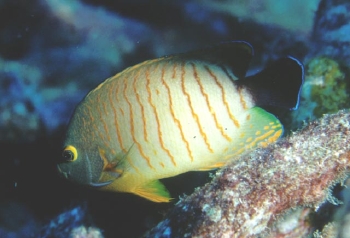
By Bob Goemans

Likely Reef Tank Suitable
Likely Fish-Only Tank Suitable
Range: Indo-West Pacific Ocean: Maldives, Sri Lanka, Andaman Sea, Indonesia, and south to northern Australia.
Size: 6 inches (15 cm)
Natural Environment: Inhabits coral rich and rocky areas on seaward reefs at depths from 3 – 80 feet (1 – 25 m), and feeds mainly on algae. Males form small social groups having two to five females.
General Husbandry: This beautiful dwarf angelfish has a pearlescent/grayish body with several orange to red vertical stripes, with the rear of the body and tail black and edged in a brilliant blue. Its highly recommended it be added to only well established aquariums containing lots of live rock that will provide it many caves and crevices to explore and/or hide in when feeling threatened.
As to diet, its an excellent browser of filamentous algae, microalgae, and detritus, yet will also accept a wide variety of frozen foods including fortified brine shrimp, mysis, and flake food, especially Spirulina. Two feedings per day is highly recommended, as underfed specimens have a tendency to pester corals and other invertebrates. Its also recommended there be only one species from this dwarf angelfish genus in the aquarium, as they develop aggression toward other dwarf angelfish species.
Not suited for small nano style aquariums, as they will become very aggressive in small surroundings, and furthermore, without numerous feedings per day, be able to find enough food to be maintained long-term.
Taxonomy:
Order: Perciformes
Suborder: Percoidei
Family: Pomacanthidae
Genus: Centropyge
FYI: Has crossbred with other Centropyge species, e.g., C. vrolikii and C. flavissimus producing attractive hybrids that are infrequently available in the trade. Also a close look-alike to the Indian Ocean Mimic Tang, Acanthurus tristia.
All Centropyge species start life as unsexed individuals, but begin their adult life as females. Then, the larger or more dominant individual within small groups will change sex within a few days to a couple of weeks and become a male. Knowing that size is the main difference between the sexes, and not so much its coloration, all one needs to do is place a small and larger specimen together. Within approximately sixty days one of the two fish will have physically changed sex to accommodate the other. A reversal of this sex change is possible if the need arises, but that requires much more time, e.g., weeks to months.
Keep in mind all angels have cheekspines at the edge of their gill cover; therefore use caution when handling and also avoid using a net to capture it, as it may become stuck or tangled in the net and become damaged when removed.
Experience Level: Intermediate
Temperament: Semi-aggressive
Diet: Omnivore
Acclimation Time: 30 minutes+
Aquarium Environment: Reef aquarium (see below) or fish-only aquarium
Reef Safe: With caution – underfed specimens have a tendency to nip clam mantles, sea anemones, and large and small–polyped stony (LPS/SPS) corals.
Minimum Tank Size: 50 gallons
Temperature Range: 71 - 79°F (22 – 26°C).
Specific Gravity: 1.020-1.026
pH: 8.0 - 8.5
